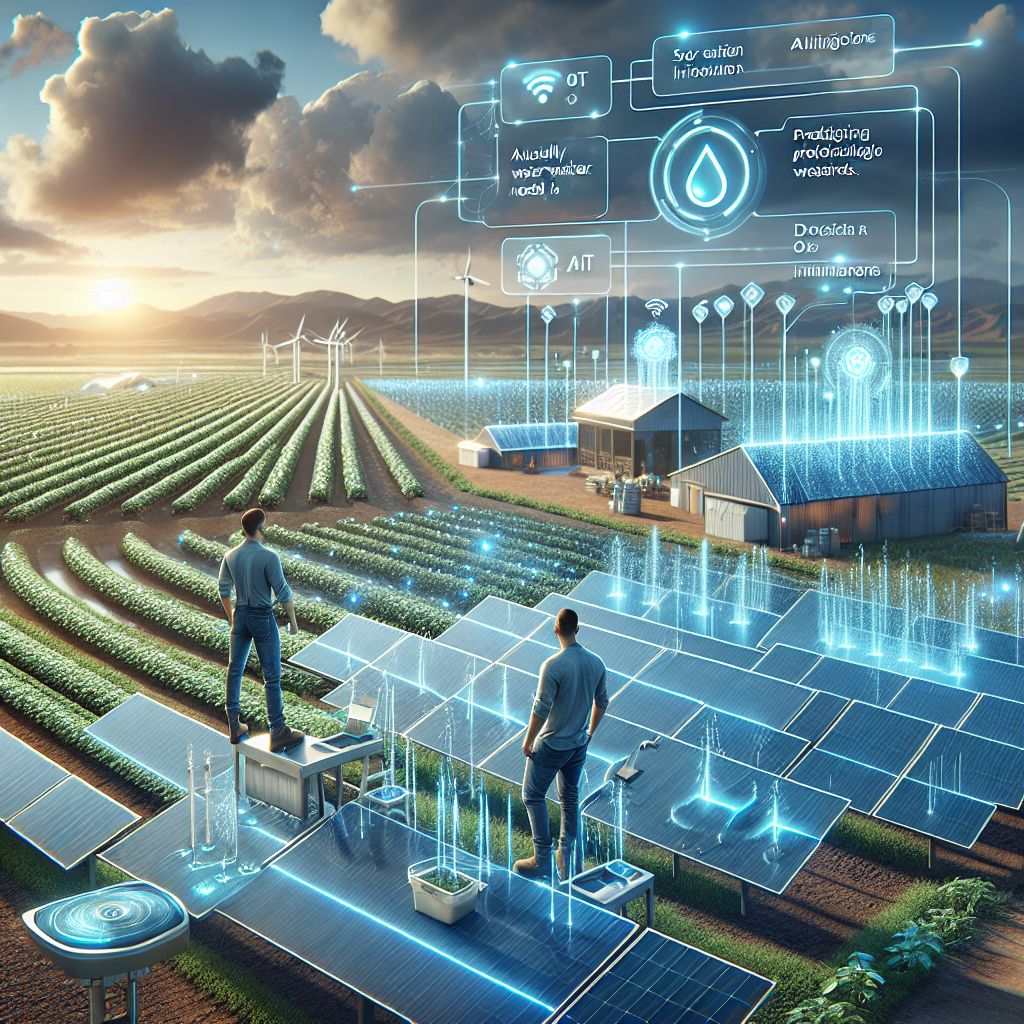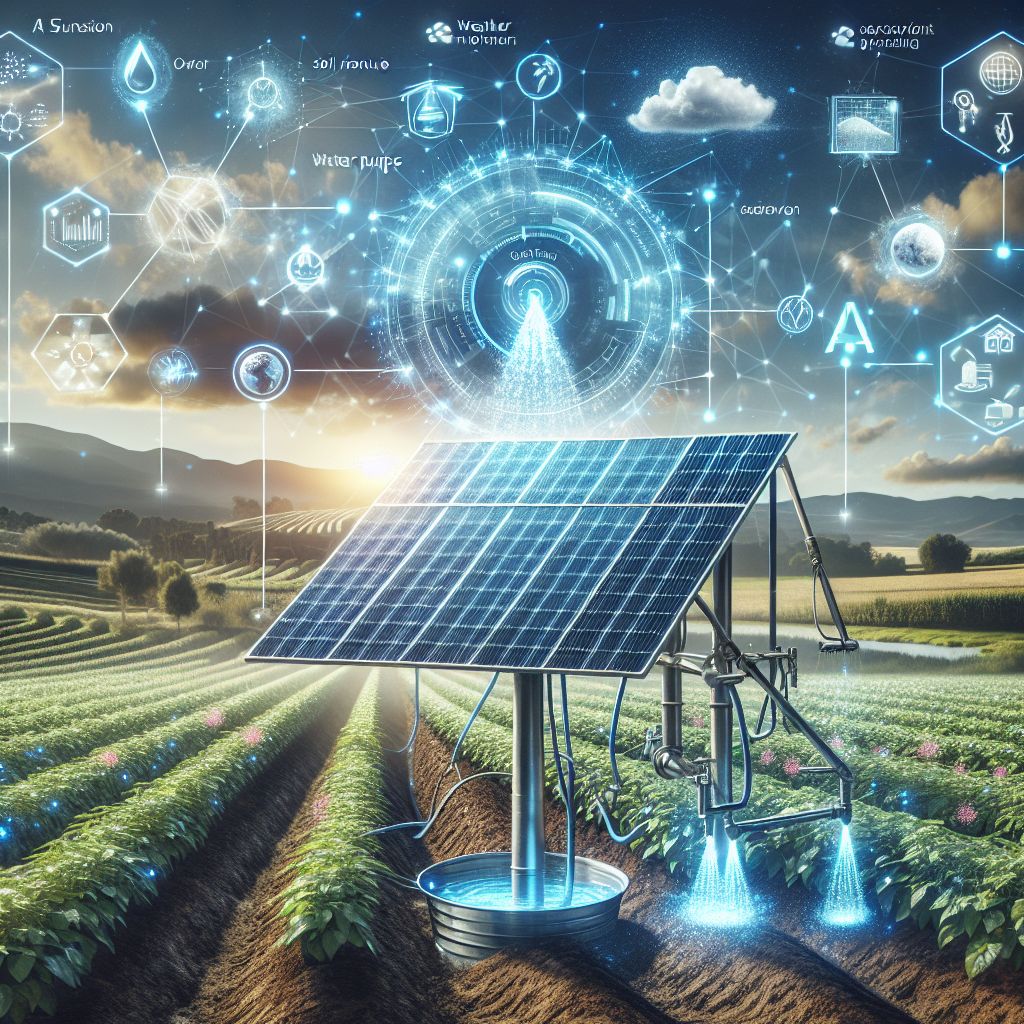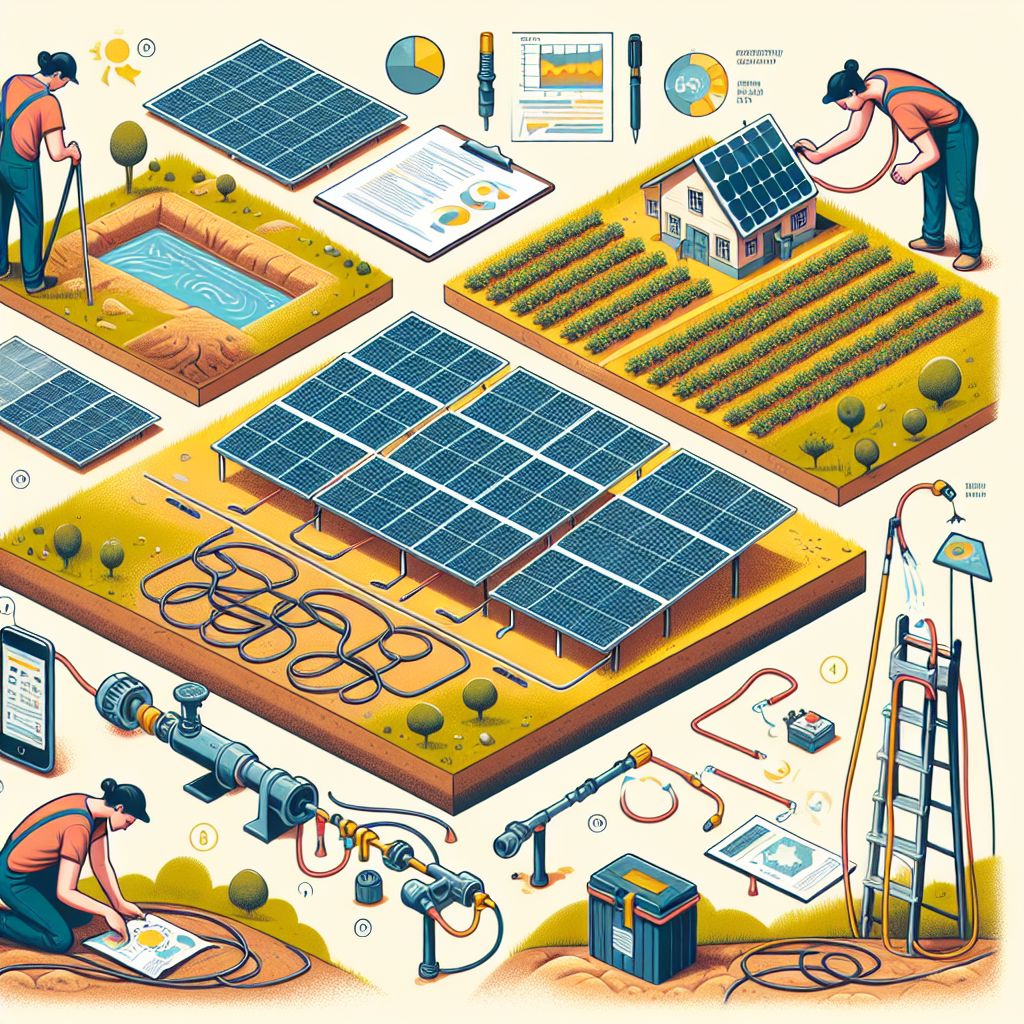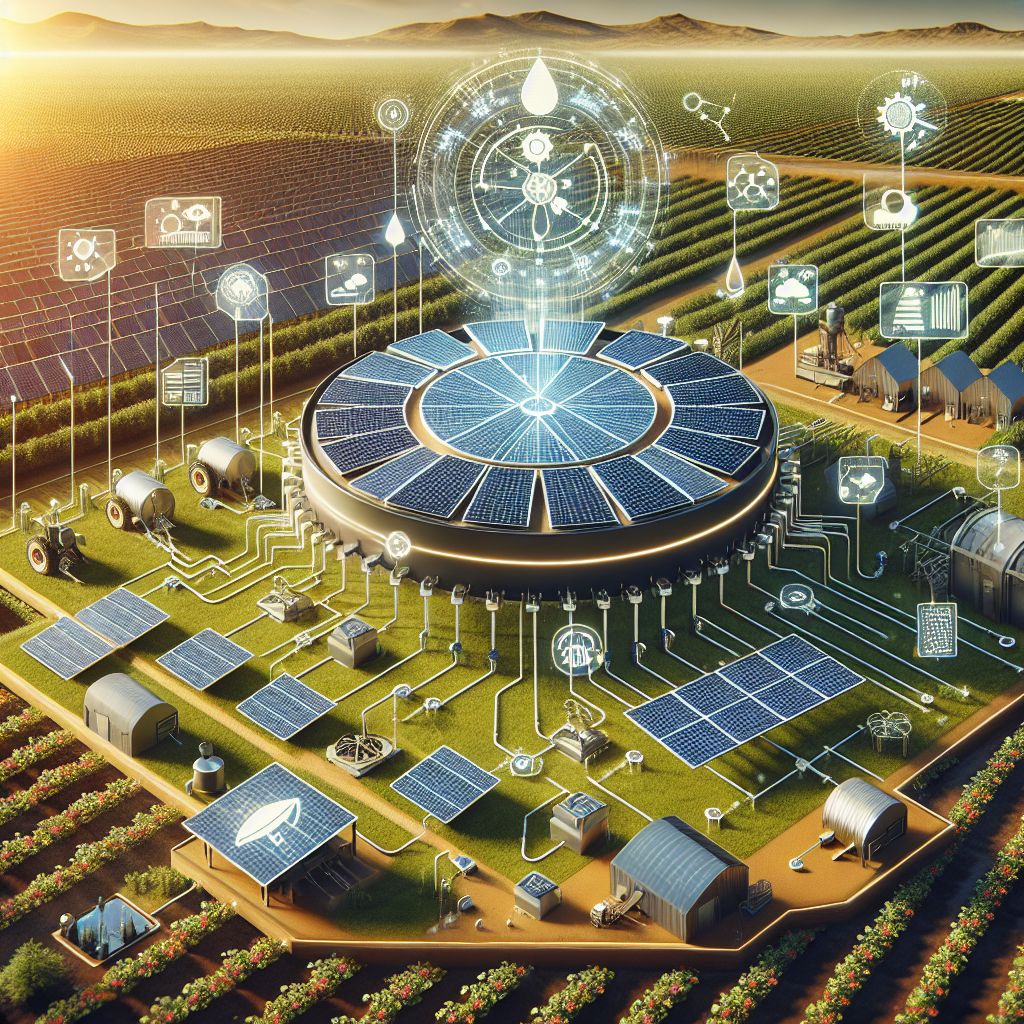
Key Takeaways
-
Solar irrigation systems are cost-effective and eco-friendly solutions for modern farming.
-
Integrating new technology, such as AI and IoT sensors, can significantly increase water and energy efficiency.
-
Choosing the right solar irrigation system depends on several factors including land size, crop type, and climate conditions.
-
Maintenance is straightforward but essential for the longevity and effectiveness of the system.
-
There are financial incentives available, like grants and tax breaks, to help farmers transition to solar irrigation.
Unlock the Power of the Sun with Solar Irrigation Technology
Solar irrigation is more than a trend; it’s a revolution in how we approach agriculture and resource management. It’s a blend of traditional farming wisdom and cutting-edge technology, designed to harness the sun’s energy to power irrigation systems. This means farmers can water their crops efficiently, save on energy bills, and contribute to a healthier planet.
What Solar Irrigation Systems Are
At its core, a solar irrigation system uses photovoltaic panels to convert sunlight into electricity. This electricity then powers a pump that draws water from a source—be it a well, a pond, or a river—and delivers it to the crops. It’s a simple yet profoundly impactful concept, as it allows for irrigation in remote areas without access to the electrical grid and reduces dependency on fossil fuels.
What Is the New Technology for a Solar Irrigation System
The latest advancements in solar irrigation involve smart technologies like artificial intelligence (AI) and IoT (Internet of Things) sensors. These additions make it possible to monitor various factors such as soil moisture levels, weather forecasts, and water usage in real-time. This information is then used to automate and optimize the irrigation schedule, ensuring that crops receive the precise amount of water at the right time.

Shining a Light on New Technology in Solar Irrigation
Implementing new technology into solar irrigation systems transforms them from static setups into dynamic, responsive solutions. For instance, IoT sensors can detect changes in weather patterns, and AI algorithms can predict future water needs, adjusting the irrigation schedule accordingly to prevent water waste.
Technology Enhances the Efficiency of Solar Irrigation on Farms
Why is efficiency so critical? Because every drop of water and ray of sunlight counts. By optimizing the irrigation process, farms can achieve higher crop yields and better crop health. Plus, with efficient use of resources, the environmental footprint of farming diminishes, which is a significant step toward sustainable agriculture.
Wave Goodbye to Electricity Bills with New Technology in Solar Irrigation Systems
Electricity bills can take a big bite out of a farm’s budget. With solar irrigation, the sun’s energy is free, meaning once you’ve covered the initial setup costs, the energy required to run your irrigation system is essentially free. This can result in substantial savings over time, especially as traditional energy costs continue to rise.

How AI can help Efficiency of a Solar Irrigation System
The use of solar irrigation systems has become increasingly popular in recent years due to the growing need for sustainable and efficient farming practices. These systems use solar energy to power water pumps and provide irrigation to crops, reducing the dependence on fossil fuels and minimizing the environmental impact. However, as with any technology, there is always room for improvement. This is where AI comes into the picture, offering the potential to significantly enhance the efficiency and effectiveness of solar irrigation systems.
AI-powered sensors and monitoring systems
One of the main challenges faced by traditional solar irrigation systems is the lack of real-time monitoring and control. AI-powered sensors and monitoring systems can be installed in solar irrigation systems to collect and analyze data in real-time. This data can include weather conditions, soil moisture levels, and water usage. By continuously monitoring this data, the AI system can make informed decisions and adjustments to optimize the irrigation process. For example, if the soil moisture levels are low, the AI system can automatically increase the amount of water being pumped, ensuring that the crops receive adequate irrigation without wasting water.
Benefits of AI Working with a Solar Irrigation System
AI has the potential to significantly enhance the efficiency and effectiveness of solar irrigation systems. By providing real-time monitoring, optimizing energy usage, and detecting malfunctions, AI can help save water, reduce operational costs, and increase crop yields. With the growing demand for sustainable agricultural practices, the integration of AI in solar irrigation systems is a step in the right direction towards achieving a more efficient and environmentally friendly farming industry.
|
Benefits For Using AI in Solar Irrigation System |
|---|
|
AI-Driven Optimization |
|
AI algorithms optimize irrigation schedules by analyzing data from IoT sensors, weather forecasts, and plant requirements, enhancing water usage efficiency and crop yields. |
|
Predictive Maintenance |
|
AI detects equipment failures in the system by analyzing IoT sensor data, enabling proactive maintenance and minimizing downtime. |
|
Energy Consumption Optimization |
|
AI optimizes energy usage by analyzing data from IoT sensors to determine the most efficient times for pumping water based on solar availability and storage levels. |
|
Data-Driven Decision Making |
|
AI processes data from IoT sensors to make informed decisions regarding irrigation timing, volume, and resource allocation, leading to improved agricultural productivity. |
How IoT can help Efficiency of a Solar Irrigation System.
The use of solar energy in agriculture has been gaining popularity in recent years, with the increasing focus on sustainable and eco-friendly practices. One of the key components of a solar-powered irrigation system is the ability to efficiently manage and control water usage. This is where the IoT technology comes into play, offering a range of benefits that can enhance the efficiency of a solar irrigation system.
IoT refers to the network of physical devices, vehicles, and other objects that are embedded with sensors, software, and connectivity, allowing them to collect and exchange data. In the case of a solar irrigation system, this technology can be used to monitor and automate various aspects of the system, resulting in improved efficiency and better overall performance.
Benefits of using IoT technology a Solar Irrigation System
IoT technology has the potential to revolutionize the efficiency of solar irrigation systems. By providing real-time monitoring and control, predictive maintenance, optimized water usage, remote management, and data-driven decision-making, it can significantly improve the performance and productivity of agriculture. With the world facing challenges of water scarcity and climate change, the integration of IoT with solar irrigation systems can play a crucial role in promoting sustainable and efficient farming practices.
|
Benefits For Using IoT in Solar Irrigation System |
|---|
|
Real-Time Monitoring |
|
IoT sensors continuously monitor soil moisture, temperature, humidity, and solar radiation, providing real-time data for AI analysis and timely interventions. |
|
Scalability and Flexibility |
|
IoT technology offers scalability and flexibility, enabling solar irrigation systems to adapt to different field conditions, crop types, and locations. |
|
Environmental Sustainability |
|
IoT sensors help reduce water wastage and energy consumption, promoting environmental sustainability by mitigating the ecological impact of traditional irrigation practices. |
|
Cost Savings |
|
IoT-enabled real-time monitoring and optimization lead to cost savings by minimizing water and energy usage, reducing labor costs, and optimizing resource allocation. |
|
Improved Crop Quality and Yield |
|
IoT data-driven insights enhance crop management practices, leading to improved crop quality and yield through precise irrigation, fertilization, and pest management strategies based on real-time environmental conditions. |
Adding Technology to a Solar Irrigation System
Essential Components for the Setup
To set up a solar irrigation system, you’ll need several key components:
-
Photovoltaic (PV) panels to capture sunlight.
-
An inverter to convert the solar energy into usable electricity.
-
A pump to move the water from the source to the crops.
-
Batteries to store excess energy for use when sunlight is not available.
-
Controllers and sensors to automate and monitor the system.
Each component plays a vital role, and it’s important to ensure they are all compatible and correctly sized for your farm’s specific needs.
Choosing the Right System for Your Farm
Selecting the appropriate solar irrigation system is not a one-size-fits-all process. You’ll need to consider:
-
The size of your land and the type of crops you’re growing.
-
The average sunlight your location receives throughout the year.
-
Your water source and its proximity to the fields.
It’s also wise to consult with a solar irrigation expert who can assess your unique situation and recommend the best system for you.

Through the Farmers’ Eyes: Success Stories
Real-life success stories can shine a light on the potential and practicality of solar irrigation systems. Farmers who have made the switch are seeing tangible benefits, from reduced costs to improved crop health. Here are a couple of examples that illustrate the impact of this technology.
Case Study: Increased Crop Yields
John, a farmer from California, decided to implement a solar irrigation system to manage his almond orchard more sustainably. After installation, he noticed a consistent increase in yield. The system’s precision watering, powered entirely by solar energy, meant his trees received the optimal amount of water at the right times, despite the region’s frequent droughts. His yield increased by 20% in the first year alone, a testament to the effectiveness of combining solar power with smart irrigation technologies.
Case Study: Enhanced Water Conservation
In Arizona, a vegetable farm was facing strict water usage regulations due to a prolonged drought. The farm’s owner, Sofia, installed a solar-powered irrigation system with soil moisture sensors. These sensors provided data that allowed the system to water crops only when necessary, leading to a 30% reduction in water use while maintaining crop health. Sofia’s farm is now an example in the community of how to conserve water without sacrificing yield.

Step-By-Step Installation Guide
Installing a solar irrigation system might seem daunting, but it can be broken down into manageable steps. Whether you’re a DIY enthusiast or planning to hire professionals, understanding the process is beneficial.
Surveying Your Land for Solar Readiness
The first step is to evaluate your land’s suitability for a solar irrigation system. This involves checking the solar insolation in your area, which is a measure of how much solar radiation your land receives. It’s also essential to assess the soil type, topography, and any potential shading from trees or buildings that might affect solar panel efficiency.
Assembling the Solar Irrigation Kit
Once you’ve determined that your land is suitable for solar irrigation, the next step is to assemble the kit. You’ll need to install the photovoltaic panels, usually on sturdy mounts, connect them to the inverter and batteries, and set up the pump and irrigation lines. Ensuring all components are correctly connected and tested is crucial for the system’s success.

The Tech Behind the Tech: How Solar Irrigation Works
Imagine a farm where the irrigation system knows exactly when to water the crops, using just the right amount, and all of it powered by the sun. That’s the beauty of solar irrigation technology.
But how does it all come together? The secret lies in the synergy between the solar panels, the pump, and the smart controller.
The Role of Photovoltaic Panels
Photovoltaic panels, or solar panels, are the heart of a solar irrigation system. They convert sunlight into direct current (DC) electricity. The amount of power generated depends on the size of the panels, the efficiency of the cells, and the amount of sunlight they receive. Larger farms may require more panels to meet their irrigation needs.
The Smart Controller: Brains of the Operation
The smart controller is the brain of the solar irrigation system. It receives data from weather stations and soil moisture sensors, making decisions about when and how much to irrigate. It then sends signals to the pump to deliver water according to the schedule. The controller can be programmed manually or set to adjust automatically based on the data it receives, ensuring efficient water usage.
Maintenance and Troubleshooting
Maintenance is crucial for keeping your solar irrigation system running efficiently. Regular cleaning of solar panels, checking connections, and testing the pump and sensors will help prevent issues. But even with the best maintenance, problems can arise.
Keeping Your System Running Smoothly
To keep your system running smoothly, you should:
-
Inspect solar panels for dirt or debris that can block sunlight and reduce efficiency.
-
Check all electrical connections for signs of wear or corrosion.
-
Test the pump regularly to ensure it’s operating correctly.
-
Calibrate sensors and controllers to maintain accurate readings and schedules.
What to Do When Issues Arise
If you encounter problems, such as a drop in water pressure or erratic irrigation patterns, the first step is to troubleshoot the system components. Check the solar panel output, battery charge levels, and sensor functionality. If you can’t resolve the issue, contacting a professional with experience in solar irrigation systems is advisable.
Funding and Incentives for Going Solar
The transition to solar irrigation is an investment in the future of your farm, but it doesn’t have to be a financial burden. Various funding options and incentives can help offset the initial costs.
Grants and Loans: A Helping Hand
Farmers may have access to grants and low-interest loans designed to promote sustainable practices. Organizations like the USDA offer programs such as the Rural Energy for America Program (REAP), which provides financial assistance for renewable energy systems.
Tax Breaks and Other Financial Benefits
In addition to grants and loans, tax incentives can make solar irrigation systems more affordable. For example, the federal solar investment tax credit (ITC) allows you to deduct a percentage of the solar system cost from your federal taxes. Some states also offer additional incentives, rebates, and tax breaks.
FAQ
Adopting new technologies often comes with questions. Let’s address some of the most common queries about solar irrigation systems to help you make an informed decision.
How Much Can I Expect to Save on Water Bills?
While the amount you can save on water bills varies depending on your location and the size of your farm, it’s not uncommon for solar irrigation systems to reduce water usage by up to 30%. This is due to the precise delivery of water directly to plant roots and the ability to adjust watering schedules based on real-time data.
Are Solar Irrigation Systems Difficult to Install?
Installation complexity can vary, but generally, solar irrigation systems are designed for ease of use. Many kits come with clear instructions, and some companies offer installation services. If you’re handy and comfortable with basic tools, you might be able to handle the installation yourself.
However, for larger or more complex setups, or if you’re not confident in your ability to install the system, professional installation is recommended. This ensures that the system is set up correctly and functioning at its best from the start.
Can I Use a Solar Irrigation System in a Cloudy Climate?
Yes, solar irrigation systems can still function in cloudy climates. Solar panels can capture diffused sunlight on overcast days, though they are most effective with direct sunlight. Battery storage is key in these climates, ensuring that there is a reserve of energy for days when the sun is less visible.
Is Solar Irrigation Feasible for Large-Scale Farming?
Solar irrigation is absolutely feasible for large-scale farming. The scalability of solar systems means they can be expanded to meet the needs of larger operations. Some of the world’s biggest agricultural producers have successfully implemented solar irrigation on a grand scale.
What Is the Lifespan of a Solar Irrigation System?
The lifespan of a solar irrigation system can be quite long, with many components like solar panels and pumps designed to last 20 years or more. Regular maintenance can help extend the life of the system, and as technology advances, components can be updated or replaced to keep the system running efficiently.
Conclusion: Technology Helps the Solar Irrigation System Be More Efficient
Embracing solar irrigation technology is a smart move for today’s farmers. It’s not only about being eco-friendly but also about the practical benefits that directly impact the bottom line. With advancements in AI and IoT, solar irrigation systems have become more efficient and user-friendly than ever before.
And remember, the transition to solar is supported by various funding and incentives that can help offset initial costs. The future of farming is bright, and with solar irrigation, you’re not just following a trend—you’re investing in a sustainable and profitable future for your farm.






